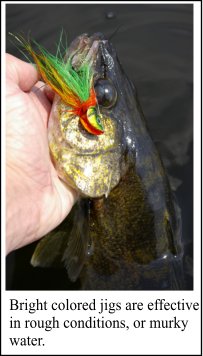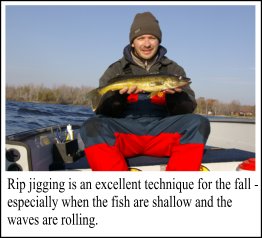Bucktail Jigging For Weed
Walleye When walleye head to the shade
of the salad, or cruise along the edge of vegetation, a bucktail jig can
be your greatest tool for seducing them to strike. Not only is the
undulating hair a visual stimulant, but also the
A standard bucktail jig is comprised of a lead head, with layers of bucktail tied and glued to the collar of the bait. Strands of tinsel are often interwoven, adding an additional aspect in terms of visual attraction. When moving, the hair forms a streamlined body, replicating a baitfish perfectly. At rest the hair fans out, adding a different dimension in terms of appearance. In comparison to a jig and plastic, the bucktail is far superior in terms of weedlessness, making them an excellent choice when the cover becomes thick and the walleye go into hiding. The Laws of Rip Jigging
Depending on the mood of the fish, rips can be positively violent or more controlled. I find that the warmer the weather, the more aggressive you can be. Walleye are an opportunistic feeder. They will conceal themselves in the thickest of cover, waiting to ambush an unsuspecting baitfish as it swims by. Ripping a bucktail jig through the salad will easily get their attention (due to the commotion it causes) and make them commit to the speedy meal before it gets away. Depending on the mood of the fish, they will either smack it as it breaks free from the green stuff, or rise to engulf it as it slowly falls back down.
In terms of tipping options for rip jigging, I prefer to go the route of none. Minnows and worms won't last long with the constant weed contact, and due to the speed of the retrieve (and split second reaction time), I haven't found that it makes much of a difference in terms of catch rates. Dunking For Fish
Pounding depths between four and 10-feet is your best option, and clear water is always your best bet. Work weed flats and clumps with the wind or an electric motor, lowering a heavy bucktail jig into every hole and edge you drift over. Let it sink directly to bottom, and give it a few lifts and drops before moving on. (I prefer to leave my bait in each hole for at least ten seconds before trying the next.) Walleye will situate themselves on these edges, both inside and out, pouncing on any bait that free falls into their lair. Visually, this is a fun and exciting tactic to employ, as most fish are actually observed sucking up the bait in the blink of an eye, and quickly charging back into the weeds! A lightening quick hook set and medium-heavy rod is recommended if you hope to put a net under the belly of any of them. Tipping your jig with a minnow or worm is an excellent choice for this short-line tactic, as the fish has more time to be convinced to strike, and scent can be a contributing factor for that. Swimming Them In Your presentation will resemble a minnow making its way along bottom, and an easy meal in the eyes of our yellow predator. Top Ten Tips For Bucktail Fishing 1. For clear water conditions,
match the hatch when it comes to colour. Murky water requires brighter
hues.
|


 erratic
cadence of the bait as it is ripped and jigged with vigor. Working
bucktails is a different game than with regular jigs, but the technique
speaks for itself with the big results you'll be rewarded with.
erratic
cadence of the bait as it is ripped and jigged with vigor. Working
bucktails is a different game than with regular jigs, but the technique
speaks for itself with the big results you'll be rewarded with. This
is one technique that has worked well for me during the fall period. Fish
will raise their activity level and feedbag at this time, and when the
wind howls and the fish move shallow, you can definitely get into a bunch.
This
is one technique that has worked well for me during the fall period. Fish
will raise their activity level and feedbag at this time, and when the
wind howls and the fish move shallow, you can definitely get into a bunch.